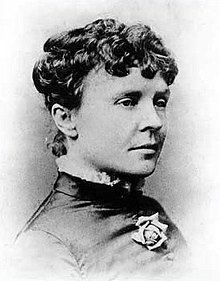Succeeded by Frances Cleveland | Name Rose Cleveland Siblings Grover Cleveland | |
 | ||
Born June 13, 1846Buffalo, New York, U.S. ( 1846-06-13 ) Books George Eliot's Poetry, and Other Studies Nieces Ruth Cleveland, Esther Cleveland Similar People Grover Cleveland, Frances Folsom Clevelan, Esther Cleveland, Ruth Cleveland, Martha Washington | ||
Rose Elizabeth Cleveland (June 13, 1846 – November 22, 1918), was the de facto First Lady of the United States from 1885 to 1886, during the first of her brother, President Grover Cleveland's two administrations.
Contents
Life and career
Rose Elizabeth Cleveland was born in Fayetteville, New York, on June 14, 1846. Known to her family as "Libby", Rose was the youngest of nine children born to Richard Falley Cleveland and Ann Neal Cleveland. In September 1853, the family moved to Holland Patent, New York, where her father had just been appointed pastor of the Presbyterian church. He died the following month, with Rose being seven years old at the time of her father's death.
She stayed in Holland Patent to care for her widowed mother. Grover Cleveland, Rose's elder brother, was 16 years old at the time. Determined to support his family, Grover left school, and he headed off to New York City to work as a teacher at the State School for the Blind to help support his family. Rose was educated at Houghton seminary in Clinton, New York and she became a teacher at Houghton in order to support herself and her widowed mother.
Rose also taught at the Collegiate Institute in Lafayette, Indiana, and at a girls school in Muncy, Pennsylvania, where she taught in the late 1860s. At Muncy Seminary Rose was known for her strong personality and independence.
Rose gained a nickname throughout her circle of friends in Muncy, they called her "Johnny Cleveland" because she was usually found reading a book under an old tree at a nearby farm. Rose then prepared a course of historical lectures; one lecture in particular focused on Altruistic Faith, which she delivered before the students of Houghton seminary and at other schools.
In the 1880s Rose returned to Holland Patent to care for her ailing mother. During this time Rose taught at Sunday School and did some work in literature. When not employed in this manner, she devoted herself to her aged mother in the homestead at Holland Patent until her mother's death in 1882. After Ann Neal Cleveland's death, Rose was left alone at the homestead known as "The Weeds."
Rose continued to teach Sunday School and give lectures. In one lecture on altruistic faith, she stated, "We cannot touch humanity at large, except as we touch humanity in the individual. We make the world a better place through our concrete relationships, not through our vague, general good will. We must each find a true partner someone who understands and appreciates us, someone whose faith in us brings out our best efforts. Our deepest craving is for recognition--to be known by another human being for what we truly are."
White House years
When her elder brother, Grover Cleveland, won the election as 22nd President of the United States, Rose became First Lady and lived in the White House for two years. She stood by her brother as First Lady during his inauguration and his two initial bachelor years in the White House.
During her early tenure as First Lady, Rose received front-page treatment from the New York Times about her appearance during her second reception at the White House. The newspaper reported that Miss Cleveland wore a dress of black satin, with entire overdress of Spanish lace. The satin bodice was cut low and sleeveless, and the transparent lace revealed the shoulders and arms. Rose Cleveland did not completely fit into Washington high society. It was said, "Rose Cleveland was a bluestocking, more interested in pursuing scholarly endeavors than in entertaining cabinet wives and foreign dignitaries." Rose was an intellectual, and she preferred to lecture rather than entertain, but she made sure to perform her duties as First Lady as a favor to her brother.
When President Cleveland married Frances Folsom, Rose resigned and began a career in education. She became the principal of the Collegiate Institute of Lafayette, Indiana, a writer and lecturer, and the editor of the Chicago-based magazine Literary Life.
Later years
At age 44, she started a lesbian relationship with a wealthy widow, Evangeline Marrs Simpson, with explicitly erotic correspondence. However things cooled off when Evangeline married an Episcopal bishop from Minnesota, Henry Benjamin Whipple.
By 1910, after his death, the two women rekindled their relationship and eventually moved to Bagni di Lucca, Italy to live there together. They shared the house with the English illustrator and artist Nelly Erichsen. Rose died at home on November 22, 1918 at 7:32 in the evening during the 1918 flu pandemic. She was buried there in the English Cemetery, and Evangeline was also buried next to Rose in the same cemetery 12 years later.
Works
She published a volume of lectures and essays under the title George Eliot's Poetry, and other Studies (New York, 1885), The Long Run, a novel (1886), You and I: Or Moral, Intellectual and Social Culture, How to Win: A Book for Girls (1887) published with feminist leader Frances Willard, and wrote the introduction for Social Mirror: A Complete Treatise on the Laws, Rules and Usages that Govern our Most Refined Homes and Social Circles. She translated The Soliloquies of St. Augustine (Boston: Little, Brown and Co. 1910), for which she wrote a lengthy introduction and extensive critical notes.
